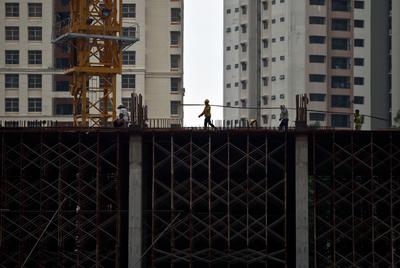Despite the lower number, GDP growth throughout 2013 accelerated, rising from 4.1 per cent in the first quarter to 5.1 per cent in the last quarter.
These are by no means bad growth figures. Given the slowing increase in the labour force over the past few decades, Malaysia’s potential for economic growth has been naturally declining. A growth rate averaging above 5 per cent for the last two years is in fact commendable, especially since Malaysia’s neighbours are doing considerably worse, relatively speaking.
But there remains a startling pessimism regarding the state of the Malaysian economy, a pessimism that transcends concerns over the cost of living, unemployment or income growth. This seems hard to account for. The economy has grown, and grown in a fairly robust manner. Real GDP growth in South Korea, Taiwan, Thailand and Hong Kong all averaged or exceeded 4 per cent between 2001 and 2010 with Singapore averaging above 5.5 per cent; Malaysia meanwhile saw growth around 4.6 per cent. Since then, average growth for the above economies was 2.9 per cent, 2.5 per cent, 3.2 per cent, 3.1 per cent, and 3.3 per cent, respectively. Malaysia by contrast averaged over 5 per cent during this time.
After the initial recovery from the global recession of 2008–09, global trade growth levelled off. Countries that were most dependent on global trade saw their economic expansion slowed. Yet in the Malaysian case that barely occurred, despite being one of the most highly exposed and open economies in the world. What explains this gravity-defying performance?
Whatever one might think of the virtues or faults of the government’s Economic Transformation Programme (ETP), it deserves the credit for Malaysia’s buoyancy. By fostering an environment conducive to investment, Malaysia saw a sudden sharp increase in capital investment, both public and private. While the infrastructure projects under the ETP hogged the limelight, private investment increased sharply as well, particularly in 2012. There’s no doubt that the resulting investment boom helped support economic growth even as external demand remained subdued.
Yet this apparent success was not broad-based. Growth was primarily concentrated in construction and its related sectors. While one could argue that investment in infrastructure such as the Mass Rapid Transit project was necessary and long overdue, there was also an accompanying boom in commercial property construction. The manufacturing sector, however, suffered from flat exports, while the primary sectors were affected by both slowing demand and softer commodity prices.
So, on the one hand, the benefits of Malaysia’s recent growth have been narrowly distributed while, on the other, risks to the economy are increased from potential over-investment in a single sub-sector.
Not that this is unusual for Malaysia. Growth in the 1990s was focused in manufacturing and construction, with the primary sector declining. Similarly, growth in the 2000s (pre-2008) saw the return of agriculture and mining, outshining growth in both manufacturing and construction as a global commodity price boom helped drive up incomes in those sectors.
The Malaysian economy is thus fairly diversified, with multiple sources of growth. This will help sustain aggregate income growth even when particular sectors are not doing so well. But in turn, it means the distribution of the benefits of that growth can and will be uneven at any given point in time.
Over the last few years, construction and real estate have been significant drivers of growth. With the recovery in the US and other advanced economies now taking root, manufacturing looks set to join the party. But the ongoing growth slowdown in China and India has affected demand and prices for primary commodities, and the outlook for the palm oil and the oil and gas sectors is not strong.
Perceptions of the state of the Malaysian economy therefore really depend on who you’re asking, and when.
Nurhisham Hussein is a Malaysian economist.

